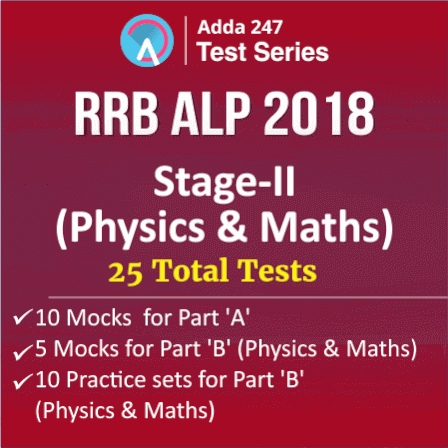Dear readers,
Looking forward to providing you the best apt study content for every government exam at no cost thus making access to the exam content convenient for you, SSCADDA is available once again to assist you thoroughly in Railway ALP Stage 2 Exam 2018 where the motive is to enable you with Physics detailed notes on definitions, concepts, laws, formulae, rules and properties, important from the exam point of view. Stay in tune with SSCADDA to utilize the remaining time for Railway ALP Stage 2 and maximize your practice skills.
HEATING EFFECT OF ELECTRIC CURRENT
The chemical reaction within the cell generates the potential difference between its two terminals that sets the electrons in motion to flow the current through a resistor or a system of resistors connected to the battery. When electric current passes through a high resistance wire, the wire becomes hot and produces heat. This is called heating effect of current. This phenomenon occurs because electrical energy is gets transformed into heat energy when current flows through a wire of some resistance say R Ω.
Consider a current I flowing through a resistor of resistance R (as given in the figure). Let the potential difference across it be V Let t be the time during which a charge Q flows across. The work done in moving the charge Q through a potential difference V is VQ. Therefore, the source must supply energy equal to VQ in time t. Hence the power input to the circuit by the source is-
P = VQ/T = VI
For a steady current I, the amount of heat H produced in time t is,
H = VIt,
where t= time in which energy is supplied
Applying Ohm’s law, we get
This is known as Joule’s law of heating.
The law implies that heat produced in a resistor is:
(i) directly proportional to the square of current for a given resistance,
(ii) directly proportional to resistance for a given current, and
(iii) directly proportional to the time for which the current flows through the resistor.
EXAMPLE:
Q. An electric iron consumes energy at a rate of 840 W when heating is at the maximum rate and 360 W when the heating is at the minimum. The voltage is 220 V. What are the current and the resistance in each case?
Solution:
We know that the power input is, P = V I
Thus the current I = P/V
(a) When heating is at the maximum rate,
I = 840 W/220 V = 3.82 A;
and the resistance of the electric iron is
R = V/I = 220 V/3.82 A = 57.60 Ω.
(b) When heating is at the minimum rate,
I = 360 W/220 V = 1.64 A;
and the resistance of the electric iron is
R = V/I = 220 V/1.64 A = 134.15 Ω.
Practical Applications of Heating Effect of Electric Current
- The electric laundry iron, electric toaster, electric oven, electric kettle and electric heater are some of the familiar devices based on Joule’s heating.
- The electric heating is also used to produce light, as in an electric bulb. Here, the filament must retain as much of the heat generated as is possible, so that it gets very hot and emits light. It must not melt at such high temperature. A strong metal with high melting point such as tungsten (melting point 3380°C) is used for making bulb filaments.
- Another common application of Joule’s heating is the fuse used in electric circuits. It protects circuits and appliances by stopping the flow of any unduly high electric current. The fuse is placed in series with the device.
You may also like to read:



No comments:
Post a Comment